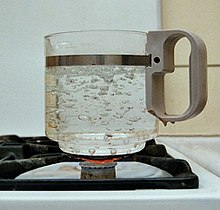Bladder (physics)
A bubble is a gaseous body within a liquid . It is separated from this by a self-contained phase interface . The complement to the bubble is the drop (liquid in gas); but see also anti-blistering .
If the bladder and fluid are at rest, the bladder is spherical . If the bladder moves towards the liquid, e.g. B. under the influence of gravity , the bladder flattens on the side in the direction of movement, increasing with speed.
In the spherical case, the internal pressure of the bladder can be calculated from
- the ambient pressure
- the surface tension of the liquid (actually the interfacial tension of the liquid / gas interface)
- the radius r :
Small bubbles therefore have a high internal pressure .
Corrosion from bubbles
In flowing , turbulent or boiling liquids, vapor bubbles of the respective liquid can form where the vapor pressure exceeds the ambient pressure and can also overcome the surface tension. Device the bladder in an area with a different thermodynamic state, where the above. If conditions are no longer present, the bubble collapses again due to the ambient pressure and the surface (interfacial) tension with condensation . Due to the inertia of the collapsing liquid, an area of very high pressure can arise at the point where the center of the bubble was , which spreads as a shock wave . If the bubble is only a tiny bit flattened and slightly asymmetrical , the collapse creates a cumulative jet with dynamic pressures that can destroy any material.
This process is known as cavitation and plays among other things. a. plays an important role in the design of hydraulic systems , pipe installations such as pumps or valves and in ship propellers .




